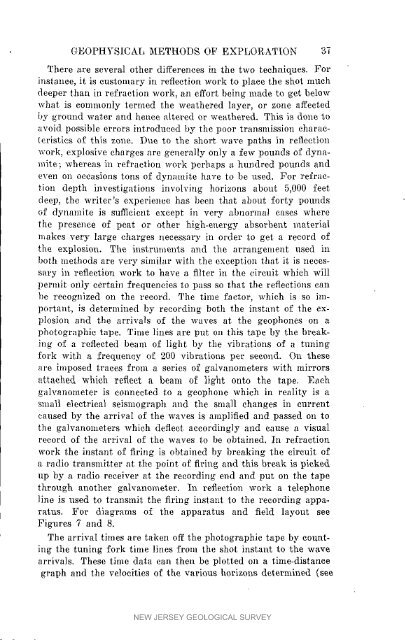Bulletin 54. Geophysical Methods of Exploration and their ...
Bulletin 54. Geophysical Methods of Exploration and their ...
Bulletin 54. Geophysical Methods of Exploration and their ...
You also want an ePaper? Increase the reach of your titles
YUMPU automatically turns print PDFs into web optimized ePapers that Google loves.
GEOPHYSICAL METHODS OF EXPLORATION 57<br />
There are several other differences in the two techniqnes. For<br />
instance, it is eustmuary in reflection work to place the shot much<br />
deeper than in refraction work, an effort being made to get below<br />
what is commonly termed the weathered layer, or zone affected<br />
by ground water <strong>and</strong> hence altered or weathered. This is done to<br />
avoid possible errors introduced by the poor transmission characteristics<br />
<strong>of</strong> this zone. Due to the short wave paths in reflection<br />
work, explosive charges are generally only a few pounds <strong>of</strong> dynamite_<br />
whereas in refraction work perhaps a hundred pouuds <strong>and</strong><br />
even on occasions tons <strong>of</strong> dynamite have to be used. For refraction<br />
depth investigations involving horizons about 5,000 feet<br />
deep, the writer's experience has been that about forty pomlds<br />
<strong>of</strong> dynmnite is sufficient except in very abnormal eases where<br />
the presence <strong>of</strong> peat or other high-energy absorbent material<br />
makes very large charges necessary in order to get a record <strong>of</strong><br />
the explosion. The instruments <strong>and</strong> the arrangement used in<br />
both methods arc very similar with the exception that it is necessary<br />
in reflection work to have a filter hi the circuit which will<br />
permit only certain frequencies to pass so that the reflections can<br />
be recognize(] on the record. The time factor, which is so important,<br />
is determined by recording both the instant <strong>of</strong> the explosion<br />
<strong>and</strong> the arrivals <strong>of</strong> the waves at the geophones on a<br />
photographic tape. Time lines are put on this tape by the breaking<br />
<strong>of</strong> a reflected beam <strong>of</strong> light by the vibrations <strong>of</strong> a tuning<br />
fork with a frequency <strong>of</strong> 200 vibrations per second. On these<br />
are imposed traces from a series <strong>of</strong> galvanometers with mirrors<br />
attached which reflect a beam <strong>of</strong> light onto the tape. Each<br />
galvanometer is connected to a geophone which in reality is a<br />
small electrical seisnmgraph <strong>and</strong> the small changes in current<br />
caused by the arrival <strong>of</strong> the waves is amplified <strong>and</strong> passed on to<br />
the galvanmneters which deflect accordingly <strong>and</strong> cause a visual<br />
record <strong>of</strong> the arrival <strong>of</strong> the waves to be obtained. In refraction<br />
work the instant <strong>of</strong> firing is obtained by breaking the circuit <strong>of</strong><br />
a radio transndtter at the point <strong>of</strong> firing <strong>and</strong> this break is picked<br />
up by a radio receiver at the recording end <strong>and</strong> put on the tape<br />
through another galvanometer. In reflection work a telephone<br />
line is used to transmit the firing instant to the recording apparatus.<br />
For diagrams <strong>of</strong> the apparatus <strong>and</strong> field layout see<br />
Figures 7 <strong>and</strong> 8.<br />
The arrival tbnes are taken <strong>of</strong>f the photographic tape by counting<br />
the tuning fork time lines from the shot instant to the wave<br />
arrivals. These time data can then be plotted on a time-distance<br />
graph <strong>and</strong> the velocities <strong>of</strong> the various horizons determined (see<br />
NEW JERSEY GEOLOGICAL SURVEY

















